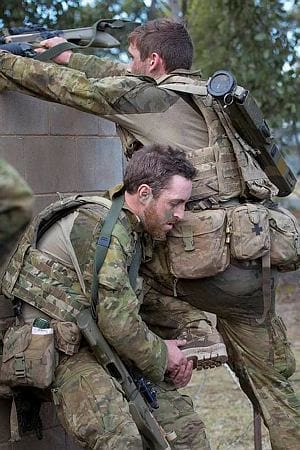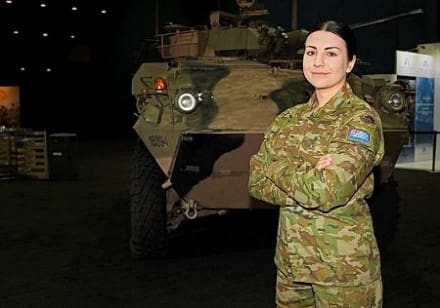Set to replace the current Disruptive Pattern Camouflage Uniform (DPCU) and Australian Multicam Pattern Operational Combat Uniform (AMP OCU) as Australian Army’s only camouflage uniform, the Australian Multicam Camouflage Uniform (AMCU) was officially launched earlier today at the Chief of Army’s Exercise in Brisbane.

(From left) Private Stephanie Sims, Private Nicolette Lane, Corporal Dean George, and Lance Corporal Keith Hall at the Australian Multicam Camouflage Uniform launch during the biennial Chief of Army’s Exercise. (Photo: Commonwealth of Australia, Department of Defence)
As we’ve mentioned in the past, the new Australian MultiCam Pattern is a hybrid pattern and color palette that combines pattern features of AMP OCU with the original color palette used for the DPCU. The kit consists of Combat and Field uniforms as well as Bush Hat, Belt and Rank Slides. Each Close Combat Soldier will receive 2 Combat uniforms and 3 Field uniforms while all others will be issued 3 Field uniforms. The design for the Combat uniform has been slightly simplified from the previous issue and all gear will be manufactured in Australia. Rollout begins next month.

Australian Army soldier Corporal Thomas McCammont from 8th/9th Battalion, Royal Australian Regiment, helps a team-mate over an obstacle during the Duke of Gloucester Cup at Singleton, NSW. (Photo: Commonwealth of Australia, Department of Defence)
Features
AMCU Combat Shirt:
-High collar in woven fabric with zip closure.
-Knit fabric body with no pockets to allow for comfort under body armor.
-Integrated elbow pad.
-Woven fabric raglan sleeves.
-Angled sleeve pockets with Velcro closure.
-Velcro adjustment tabs at cuffs.
-Pen pocket on left sleeve.
AMCU Combat Pant:
-Stretch woven fabric in back yoke (below waistband), crotch and around knee.
-Adjustable waist with advanced design.
-Padded waistband.
-Button and zip front fly closure.
-Reinforced saddle seat.
-Integrated knee pad.
-Knee pad is snugly held in correct location using elasticised cord adjustment(connects to front thigh pockets) and Velcro closure tabs at the side of the knee.
-2 side thigh pockets with zip closure.
-2 lower front thigh pockets (external – contains toggle and elasticised draw cord for knee pad adjustment) with Velcro closure.
-2 front pockets below waistband (internal).
-2 lower leg pockets with Velcro closure.
-Cord and cord lock adjustment at cuffs

Private Stephanie Sims at the Australian Multicam Camouflage Uniform launch during the biennial Chief of Army’s Exercise. (Photo: Commonwealth of Australia, Department of Defence)
AMCU Field Shirt:
-Based on the current DPCU shirt.
-Near infrared (NIR) fabric.
-5 button closure at the centre front.
-Chest pockets with zip closure.
-Sleeve pockets with button closure.
-Shorter coat length than current shirt.
-Velcro adjustment tabs at cuffs.
-Rank slide at chest
-Increased width at coat hem compared to current shirt.
-Graded sleeve length.
AMCU Field Pant:
-Stretch woven fabric in back yoke (below waistband) and crotch.
-Button and zip front fly closure.
-Adjustable waist with advanced design.
-Padded waistband.
-Integrated knee pad with Velcro closure tab.
-2 side thigh pockets with zip closure.
-2 front pockets below waistband (internal).
-Cord and cord lock adjustment at cuffs.
Australia’s Assistant Minister for Defence, The Hon Stuart Robert MP said in an interview with Foreign Affairs,
“Defence is pleased to partner with Australian companies to manufacture the AMCU. I am confident the manufacturing of the AMCU in Australia not only supports local business, but also maintains high standards and keeps pace with current technology,” Mr Robert said.
“At the moment there are two manufacturers for the AMCU – Australian Defence Apparel (ADA) and Pacific Brands Workwear Group (PBWG).”
The Australian Army offers a great fact sheet for those interested.
In closing, I’d like to point out that the Australian government modified this pattern (which is a national MultiCam derivative designed for them by Crye Precision) at their in-house labs. They could do this because they paid for the pattern.
Tags: Australia


“They could do this because they paid for the pattern. ”
“because they paid for the pattern. ”
“they paid”
The snarkyness is not lost on me. I wonder what their license or rights cost.
Probably more than the Army threw a temper tantrum about…
Im not sure that was snarky — given the earlier post I think it cuts off a lot of reasonable questions. They paid for pattern, as did UK MoD.
It was snarky.
If I recall correctly they paid about $3.1 Million for development. An additionally license brought it up to a total of $4.7 million. If you look at that as a license to outfit an Australian force of around 50,000 and then extrapolate that to a U.S. Army force of 1.1 million then that should run about $ 103.4 Million.
I always thought original Multicam was little bit too light for non-desert transitional environment. And the other traditional camouflage like woodland and tiger stripe were too dark for all around season. I want something like Pencott, but more widely available and sufficient to mil-spec standards.
And now I seeing this.. I just can’t wait to pick it up at foreign military surplus store or ebay. Might need to wait few more years but I don’t care. It looks way better than existing Aussie-cam. And will blend, match better with other commercial Multicam gears.
It’s cool that they are saving money by only issuing the combat uniform to combat troops… Apparently the “everybody is a warrior” mentality hasn’t taken hold there causing massive waste.
Sorry this isn’t 1944 with a front line. We haven’t had a front line since Korea. I guess just “warriors ” that you refer to only see combat. I know an 88M with 4 purple hearts who ran resupply missions in Iraq that would beg to differ. Guess we just keep trigger pullers and make everyone else KBR?
Good for them. I like the paint job on the vehicle too. We’re gearing up for our Mountain Peak exercise here at Drum and it’s humerous to look at all the desert tan tents and vehicles standing out against our world of green.
Good to see that the ‘next gen’ combat uniform uses a very ‘last gen’ high vis soft shirt component…. do you think the ADF and ADA knows you can get this fabric in different colors? Crye currently has 4 different ones, I’m sure the possibility exists for even more than that, yet here we are with this color….
And what is the deal with pen holders on a combat shirt and not on the admin/field shirt?
Why not put the thigh pockets on the admin/field pants? They are one of the best things about the Crye design…
And last but not least, waste millions purchasing a license to print a design to be ‘unique’ and then don’t buy the stretch fabric in your new color.. er?
ADA has no idea or concept about the stuff they churn out. Its like they just look at pictures of what other companies develop and then copy it, but have no actual idea of ‘why’ they are making it. The TBAS is the number 1 example of this, and I would put these hack job uniforms at number 2….
I forgot to add about the sleeve velcro… COME ON ADF get on board with the velcro length the rest of the world is using. Now I see they have manufactured a new style patch but in the same stupid size as the old style… opportunity lost.
Nothing better than seeing deployed ADF troops having their unit issued patches hanging half off due to the velcro being too short….
Dude, you should spend a few weeks east across the Pacific for a bit and you’ll be glad your Army gives a boot enough to at least take the majority of what industry has to offer and give it to you.
That’s “hoot” not “boot”
I hope the chest pockets on the Field Shirt open at a different angle compared to the old style shirt. Will stop everything falling out of your pockets every time you open them. This colour pallette will not work in the Pilbara region. Pilbara Regt. should be issued the old Transitional AMP Combat uniform (two sets) for out Bush.
A lot of people don’t like the look of AUSCAM, myself included, but you have to admit that it works well – especially in the Australian Outback.
I don’t really understand the branding mentality that comes with modern armies’ camouflage – first and foremost, it should work.
This new pattern, however, seems to be quite good. I’m interested to see how it works in the ‘real world’.
Is the new uniform (both variants) FR (fire resistant) ? If not why not? Does anyone know?